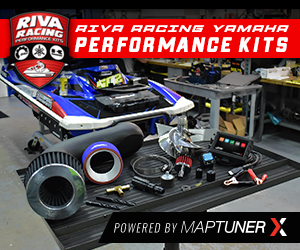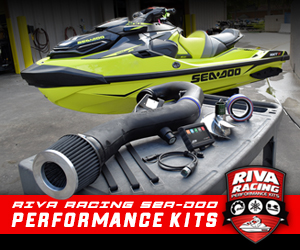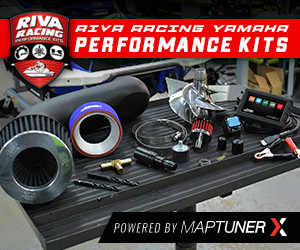
We’ve grappled with the amalgam of “luxury” and “performance.” Too often these terms get thrown around a little too loosely in our industry, and often at the hands of the OEMs themselves. What exactly makes a personal watercraft a “performance” craft is usually pretty easy to define, while a true “luxury” PWC is as difficult as nailing Jell-O to the wall. Thankfully, Yamaha Motor Corp. doesn’t pigeon-hole their various models by such limitations.
For the brand’s full-sized runabout class – the FX – there are three variations of performance; the HO, SHO and SVHO. Of course, the Super Vortex High Output package constitutes much more than Yamaha’s all-new for 2014 SVHO engine, which takes the Super High Output (SHO) engine and radically increases the overall efficiency by 110-percent.
The SHO’s cast pistons have been replaced with 8.5:1 compression forged pistons. Likewise, the SHO’s 42-pound injectors have been swapped for larger 60-pound squirters, and a larger intercooler is 22-percent more efficient over the prior unit. Lastly, a larger, 86mm HKS supercharger spools up to an impressive 60-percent more boost thanks to a new 6-vein impeller.


The SVHO package also includes a race-bred 8-vein pump housing a 160mm impeller, producing significantly more thrust. The Yamaha’s new-found power is delivered with gusto, catapulting a single rider with only a gallon or two of fuel in the 18.5 gallon tank from 0-to-30 in 1.5 seconds, and to 60mph in just over double that. Once properly broken in (a factory-suggested minimum 10 riding hours), the SVHO-powered FXs have been recorded to speed a tick or two past 70 miles per hour.
But again, the sucker punch-fast speeds of the SVHO doesn’t fully encapsulate the complete rider experience of the 2014 FX Cruiser SVHO, because although it was pretty much all we wanted to do, this particular WaveRunner isn’t defined by just hauling some serious tail around the lake.
Yamaha has taken several steps to get to this level of refinement. The current FX hull was only recently redesigned, extending the chines and massaging a few other points, hoping to inject a little more adrenaline into the three-seater segment.


Hewn from the brand’s proprietary NanoXcel material, the deceptively lightweight FX Cruiser SVHO tips the scales at 875 pounds (dry). Likewise, hours have been poured into seemingly minor details, like a flat and contoured, pistol-style hand grips, responsive and easy to reach toggles on the handlebars, and a true mechanical neutral gear (with indicator) in throw of the reverse lever.
Tilt steering has all but become a standard feature on the FX series, as well as the twist-cap dry storage found both in the dashboard – a padded cubby for cell phones, keys and wallets – as well as a watertight bin beneath the rear seat.
Yamaha’s FX units also feature one of the broadest swim platforms in the industry with a flat-topped folding swim step.
Fore and aft are ample storage, totaling 33.5 gallons of stowage. The rear box is “wet” and therefore is best suited for tow ropes and swimming accessories as the glove box and bow storage is best for valuables, towels, bags and such.


The Cruiser package not only adds the tiered and scalloped stadium-style seating, which comfortably positions riders in stepped seating, but also provides the FX a statelier Yacht Blue Metallic livery and grey-on-black Hydro-Turf matting.
Additionally, the gauge cluster features a second LCD screen to the right of the analog speedo/tachometer providing available air/water temperatures, fuel consumption rates and fuel “countdown” meter, and a digital compass.
While the additional Cruiser package digital readout was appreciated, we wish the compass wasn’t so vague, giving actually heading coordinates rather than the generic “north” or “northeast.” Likewise, the FX gauges are a little dull compared to the eye-catching cluster on its FZ platformed siblings. While easily readable and navigated, the two square LCD screens are a tad on the boring side.
Other small quibbles include Yamaha’s pop-up cleats, which are too dainty for dockside mooring lines to use effectively. Likewise, while we enjoyed the added comfort of the Cruiser seat, the thick cushioned bolster discriminates against taller riders placing us too far forward for our preference.


Yet, with a rap of the throttle, these small grievances go flying behind us like so much scenery. Without gushing too emphatically, the SVHO gallops to top speed in seconds, rises to plane almost immediately and responds almost intuitively with the flick of the trigger or a twitch of the steering. We found that despite its upper crust persona, the FX Cruiser SVHO revels in deep-in-the-tray, leaning out over the rail cornering – almost daring you to keep into the throttle longer than your brain’s caution sensor would recommend.
We love, love, love the FX SVHO in the corners with the manual trim set a notch or two down. Seriously. It’s a whole lot of fun. Just slide off to the side of your seat, drop your knee flat into the footwell, lean hard and nail the gas while snapping into a turn. It might be the g-forces at play, but the smile stretching across your face will last for hours.
With a full tank of go-juice in the SVHO’s belly, we clicked an impressive 69.8mph on our Garmin GPS. Correcting for the barometric pressure on Lake Allatoona, Georgia, that speed becomes a 70.3mph, and that’s pretty dang fast for a bone-stock factory-built runabout.
Impressively, the FX Cruiser SVHO is the industry’s biggest selling luxury performance runabout. These machines are in high demand and quite frankly, we understand why. Priced at $15,399, they come in thousands of dollars cheaper than fully-loaded offerings from both Kawasaki and Sea-Doo. Coming in lighter, less expensive and faster than the aforementioned competitors, it’s no wonder the FX Cruiser SVHO is pulling ahead of the rest.
































